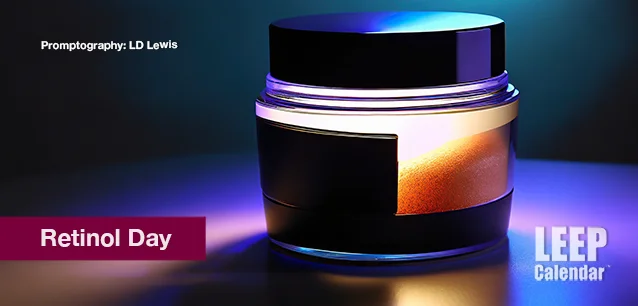 AD
AD
Today is: December 09
Scroll to explore events active on this date.
Additional Events on LEEP
LEEP INK FEATURES

August? Absolutely!
In August, we live through the Dog Days of Summer. It's hot and often humid, and those who can leave for better climates do. Down south, winter is in full force. August is also known as "the ...

In The Heat of July: July 2025 Events
Is it hot enough (or cold enough if you're below the equator) for you yet? There is actually a day for that! Like every month, I pick a diverse collection of events you may or may not know about. This ...

May Blooms: Events in May 2025
Along with October, May is one of the most densely packed months of the year. It's before the summer humidity and the last whole month of the school year. The weather is warming in t...
About Retinol Day
Women , Retail
United States
Ends: Nov 07, 2024
DESCRIPTION:
Retinol Day was created by RoC® Skincare in 2021. Retinol, a form of Vitamin A, has a storied history in the cosmetics industry, emerging as one of the most revered ingredients in skincare for its anti-aging and skin-rejuvenating properties. The journey of retinol in cosmetics began in the early 20th century.
The initial discovery of Vitamin A in the early 1900s laid the groundwork for future research into its derivatives, including retinol. However, it was in the 1960s and 1970s that dermatologists began exploring its benefits for the skin. Dr. Albert Kligman, a dermatologist, was instrumental in this exploration. He initially studied retinoic acid, a more potent form of retinol, to treat acne. His research revealed that retinoic acid effectively treated acne, reduced wrinkles, improved skin texture, and helped with skin discoloration.
This discovery led to the development of tretinoin (Retin-A), approved by the U.S. Food and Drug Administration (FDA) in the 1970s as an acne treatment. As scientists understood more about its anti-aging properties, retinol began to make its way into over-the-counter cosmetic products. Retinol, less potent than retinoic acid, was better suited for non-prescription skincare due to its lower risk of irritation.
In the 1980s and 1990s, the use of retinol in cosmetics gained momentum. Skincare companies started incorporating retinol in anti-aging products, touting its benefits for reducing fine lines and wrinkles, while improving overall skin texture and tone. Scientific research supported these claims, showing retinol's ability to stimulate collagen production and accelerate cell turnover.
The cosmetic industry's embrace of retinol led to innovations in product formulation. One challenge was retinol's instability and sensitivity to light and air, which led to more stable forms of retinol and advanced delivery systems in skincare products to enhance its efficacy and reduce potential irritation.
Today, retinol remains a cornerstone ingredient in anti-aging skincare. Its popularity has spurred a range of products, from serums to creams, tailored for different skin types and concerns. While it is widely celebrated for its benefits, dermatologists also caution about its potential side effects, such as dryness and irritation, and emphasize the importance of using it correctly.
In summary, the history of retinol in cosmetics is a testament to the evolving understanding of skincare science. From its beginnings as a vitamin discovery to its current status as a staple in anti-aging products, retinol's journey reflects the advancements in dermatological research and the ever-growing pursuit of innovative skincare solutions.
VIDEOS
SUPPORTING DOCUMENTS
Currently, this event does not have supporting documents.
ADDITIONAL IMAGES
Currently, this event does not have supporting images.
Where would you like to go now?
 AD
AD


/footer-logo.svg)
